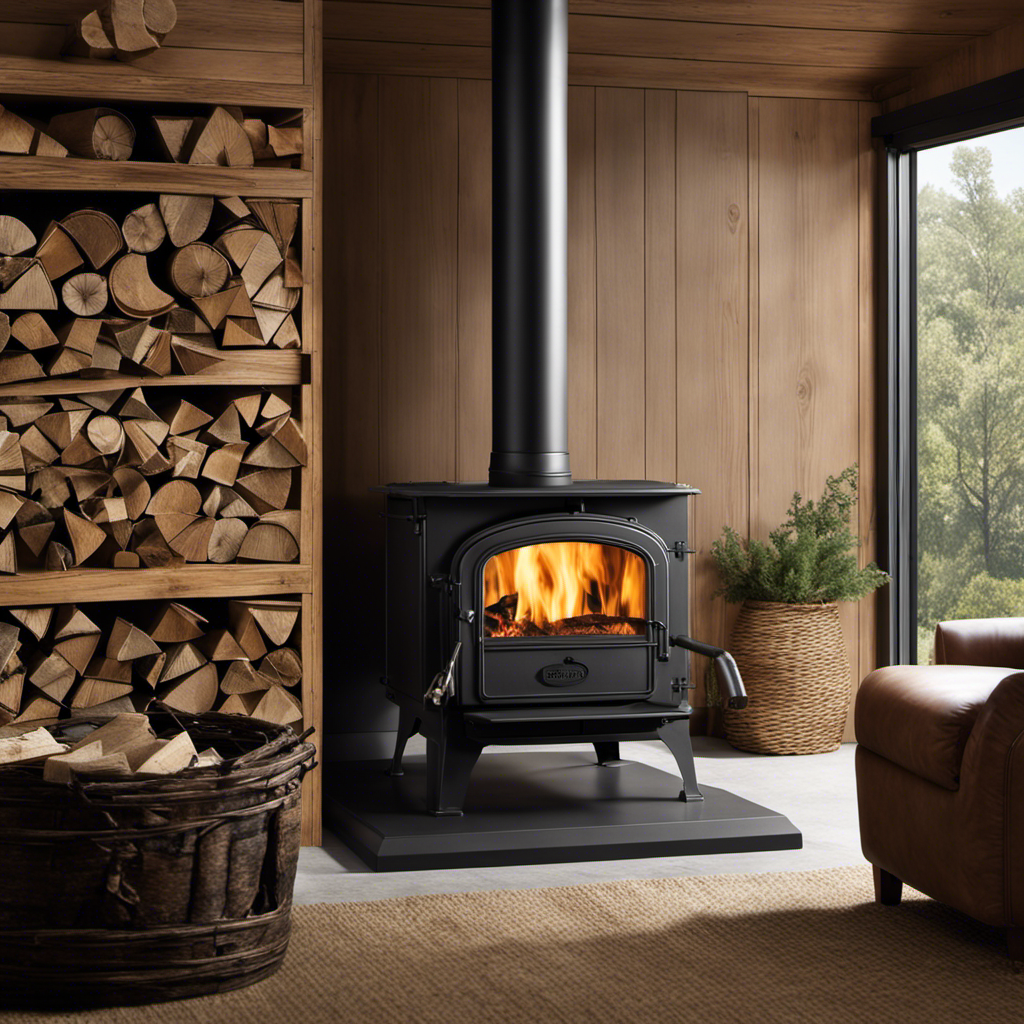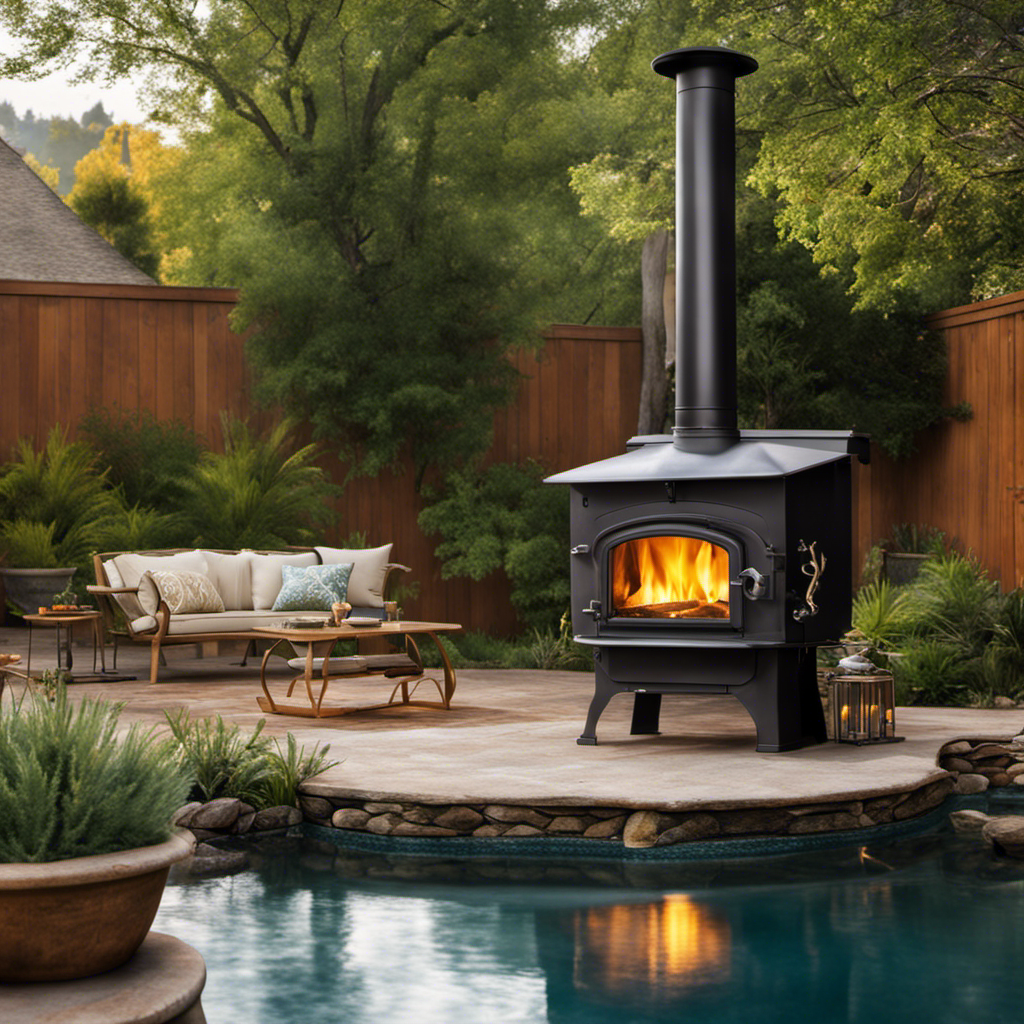Wood Stove
How To Make Your Wood Stove More Efficient

You may believe that improving the performance of your wood stove is a complicated and time-consuming task. But, I assure you, it’s easier than you might think.
In this article, I’ll guide you through simple steps to maximize the heat output of your wood stove. From choosing the right wood to improving airflow and insulating your stove, I’ll show you practical ways to enhance its efficiency.
With regular maintenance and cleaning, you’ll have your wood stove performing at its best in no time.
Key Takeaways
- Regular cleaning and inspection improve efficiency
- Burning dry and seasoned wood minimizes smoke production
- Choosing the right kind of wood maximizes heat output
- Improving airflow and combustion efficiency through regular maintenance and cleaning.
Understanding the Basics of Wood Stove Efficiency
I’m currently learning about the basics of wood stove efficiency.
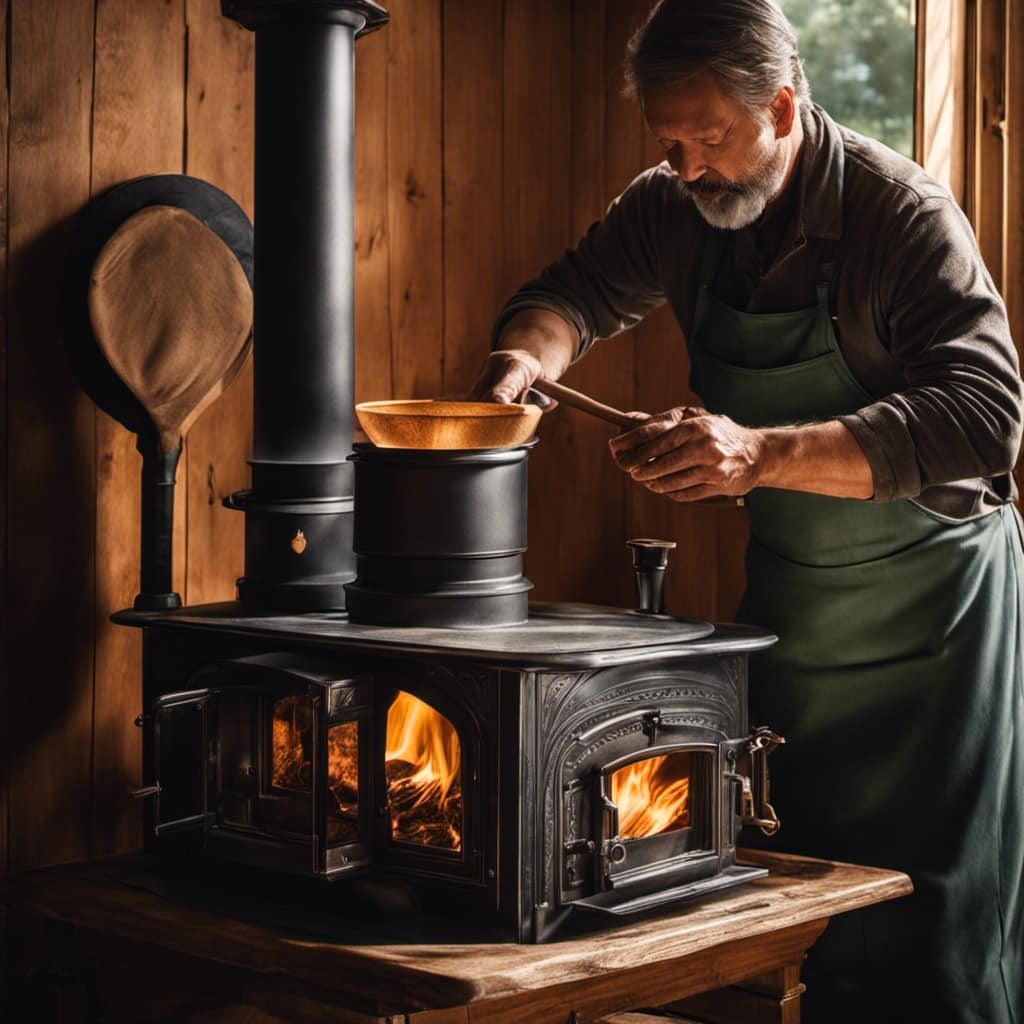
One important aspect to consider is wood stove maintenance. Regular cleaning and inspection of your stove can greatly improve its efficiency. Removing any built-up soot and debris from the stove and chimney allows for better airflow and combustion, resulting in a more efficient burn.
Another way to improve efficiency is by reducing smoke emissions. Burning dry and seasoned wood helps to minimize smoke production, as wet or unseasoned wood tends to burn inefficiently and produce more smoke.
In addition, using the right kind of wood can maximize heat output. Hardwoods like oak or maple burn longer and hotter than softwoods like pine or spruce.
Choosing the Right Wood for Maximum Heat Output
Using hardwoods like oak or maple, and not softwoods like pine or spruce, is essential for achieving maximum heat output from your wood stove. Here are a few reasons why:
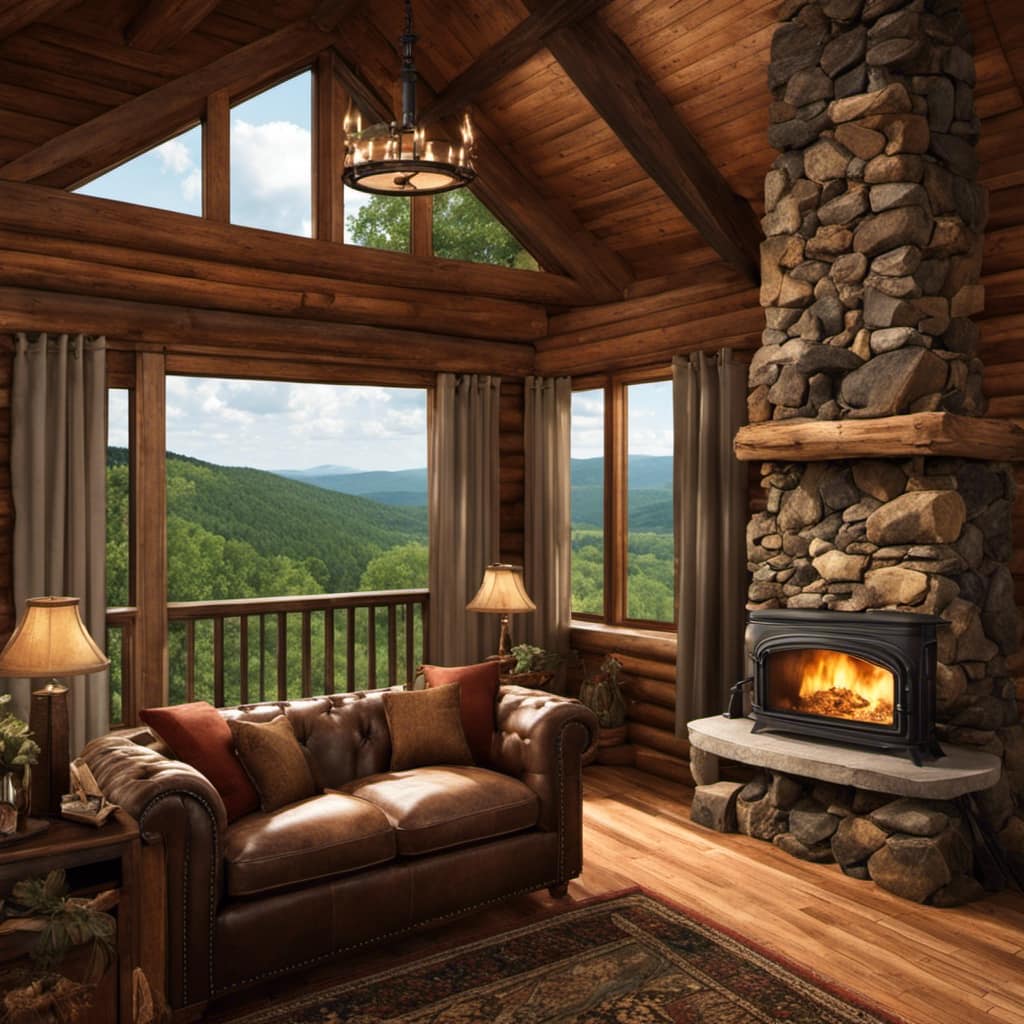
-
Seasoning wood properly:
Moisture content in wood affects its ability to burn efficiently. Hardwoods have a lower moisture content compared to softwoods, allowing them to burn hotter and produce more heat. -
Higher energy density:
Hardwoods have a higher energy density, meaning they contain more potential heat energy per volume. This results in a longer and more sustained burn, providing consistent heat output. -
Utilizing wood stove accessories for better heat distribution:
Accessories like heat fans or heat-powered stove fans can help circulate warm air throughout the room more effectively. This ensures that the heat produced by the wood stove is evenly distributed and maximized. -
Longer burn time:
Hardwoods burn slower than softwoods, resulting in a longer burn time. This means less frequent refueling and a more efficient use of wood.
Improving Airflow and Combustion Efficiency
How can I ensure proper airflow and maximize combustion efficiency in my wood stove?
One of the key factors in achieving efficient combustion is to ensure proper airflow. This can be achieved by regularly cleaning the air vents and chimney to remove any blockages that may hinder the flow of air.
Additionally, using eco-friendly fuel alternatives, such as compressed sawdust logs or wood pellets, can help improve combustion efficiency. These fuels are designed to burn more efficiently and produce less smoke and ash.
Another way to maximize efficiency is by increasing insulation around your wood stove. This can be done by installing a heat-resistant barrier or using a heat reflector to redirect the heat back into the room.

Insulating Your Wood Stove for Better Heat Retention
By insulating your wood stove and using a heat reflector, you can increase its heat retention and reduce energy waste. Here are some practical tips to make your wood stove more efficient:
-
Install a blower fan: A blower fan helps in better heat distribution by circulating the warm air throughout the room. This ensures that the heat is evenly spread, making your space more comfortable.
-
Use heat resistant glass: Upgrading to heat resistant glass for your wood stove door can significantly improve insulation. It prevents heat from escaping and allows you to enjoy the comforting sight of the fire without compromising on efficiency.
-
Seal any gaps or leaks: Inspect the areas around your wood stove for any gaps or leaks. Using high-temperature silicone or gaskets can help seal these openings, preventing heat loss.
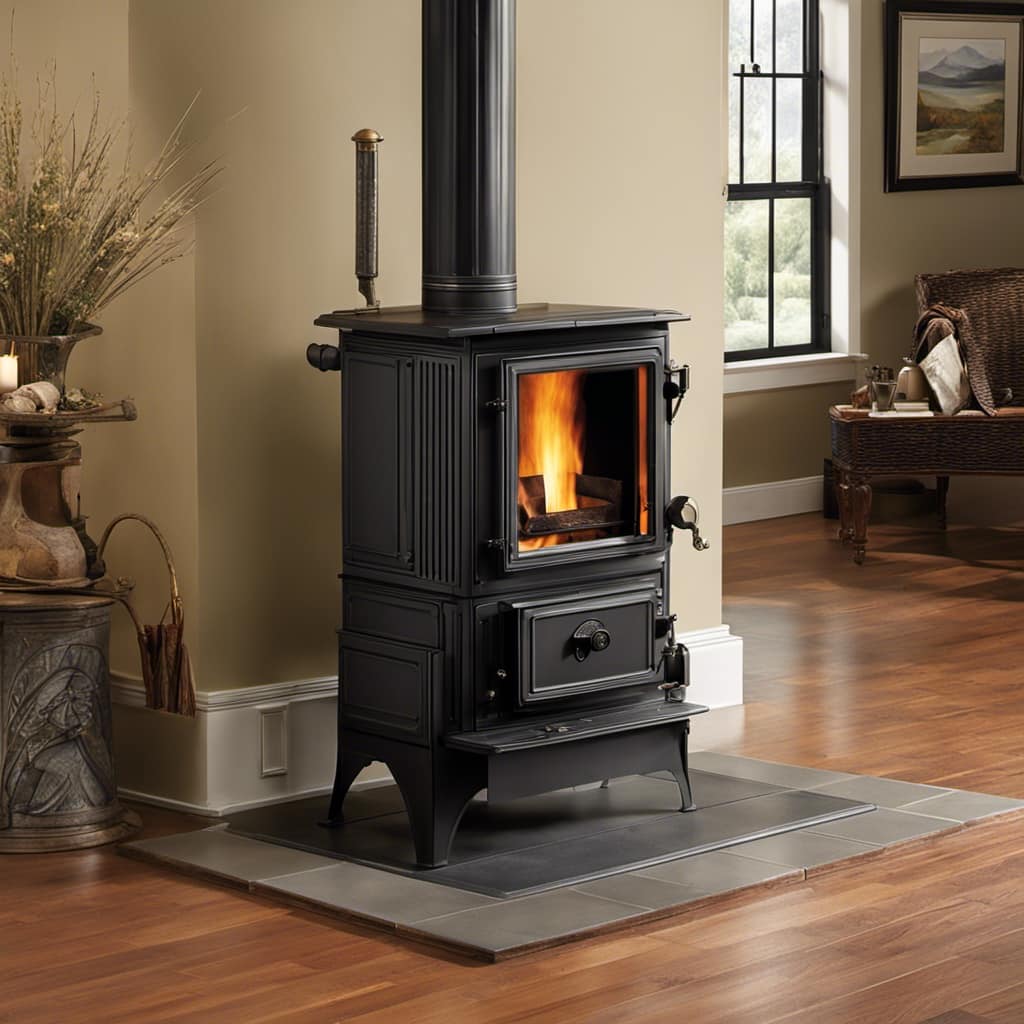
-
Add insulation around the stove: Consider adding insulation around the walls, floor, and ceiling near the wood stove to further reduce heat loss. This will help keep the heat inside the room, making it more energy-efficient.
Regular Maintenance and Cleaning for Optimal Performance
I always ensure that I schedule regular maintenance and cleaning for my wood stove to maintain its optimal performance.
Cleaning techniques are essential to keep the stove functioning efficiently. One of the most common issues with wood stoves is a buildup of creosote, which can lead to chimney fires. To prevent this, I regularly clean the interior of the stove using a wire brush and remove any creosote buildup.
Additionally, I inspect the gaskets and seals to ensure they’re intact and replace them if necessary. Troubleshooting common issues such as a weak flame or difficulty in starting the fire can often be resolved by cleaning the air vents and removing any ash or debris.

Frequently Asked Questions
Can I Use My Wood Stove to Heat My Entire Home?
Yes, I can use my wood stove to heat my entire home. Wood stove installation offers many benefits for heating, including cost savings, cozy warmth, and the ability to rely less on other heating sources.
What Are the Potential Health Risks Associated With Using a Wood Stove?
Potential health risks associated with using a wood stove include poor indoor air quality, which can lead to respiratory issues and exacerbate existing conditions. Proper ventilation and regular maintenance can help mitigate these risks.
How Can I Prevent Creosote Buildup in My Chimney?
To prevent chimney fires and remove creosote buildup, regular cleaning and maintenance are essential. I recommend scheduling annual chimney inspections, using creosote removal techniques such as chimney brushes and creosote removal products.
Can I Use Alternative Fuels, Such as Pellets or Coal, in My Wood Stove?
Yes, you can use alternative fuels like pellets or coal in your wood stove. They offer benefits such as higher heat output and longer burn times. However, it’s important to follow the manufacturer’s guidelines for safe and efficient use.
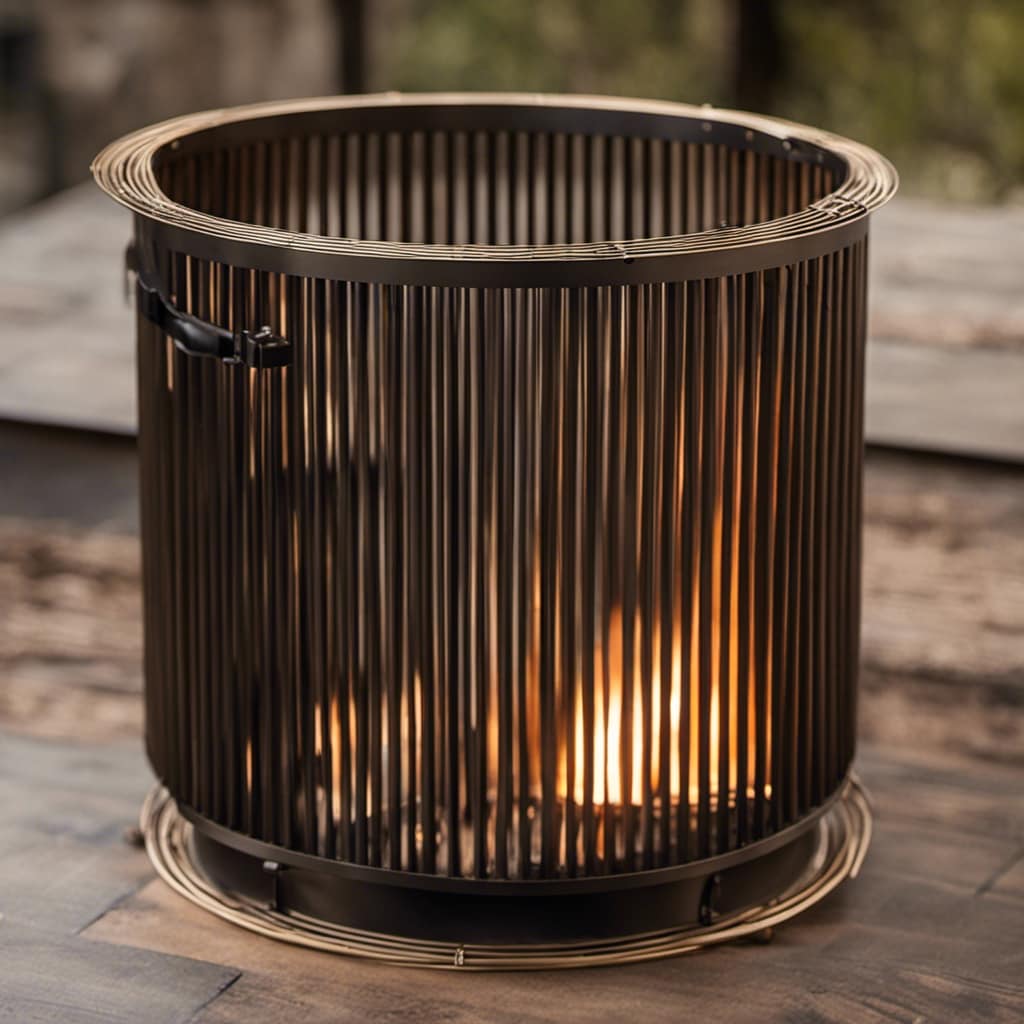
What Safety Precautions Should I Take When Using a Wood Stove?
When using a wood stove, it’s important to prioritize safety. Proper ventilation is crucial to prevent carbon monoxide buildup. Regular wood stove maintenance, such as cleaning the chimney and inspecting for leaks, is essential for safe operation.
Conclusion
In conclusion, by implementing some simple strategies, you can greatly improve the efficiency of your wood stove.
Did you know that a well-insulated wood stove can reduce heat loss by up to 80%? This means more heat stays inside your home, resulting in lower energy costs and a warmer living space.
So, take the time to choose the right wood, improve airflow, insulate your stove, and perform regular maintenance to maximize its performance and save money in the long run.
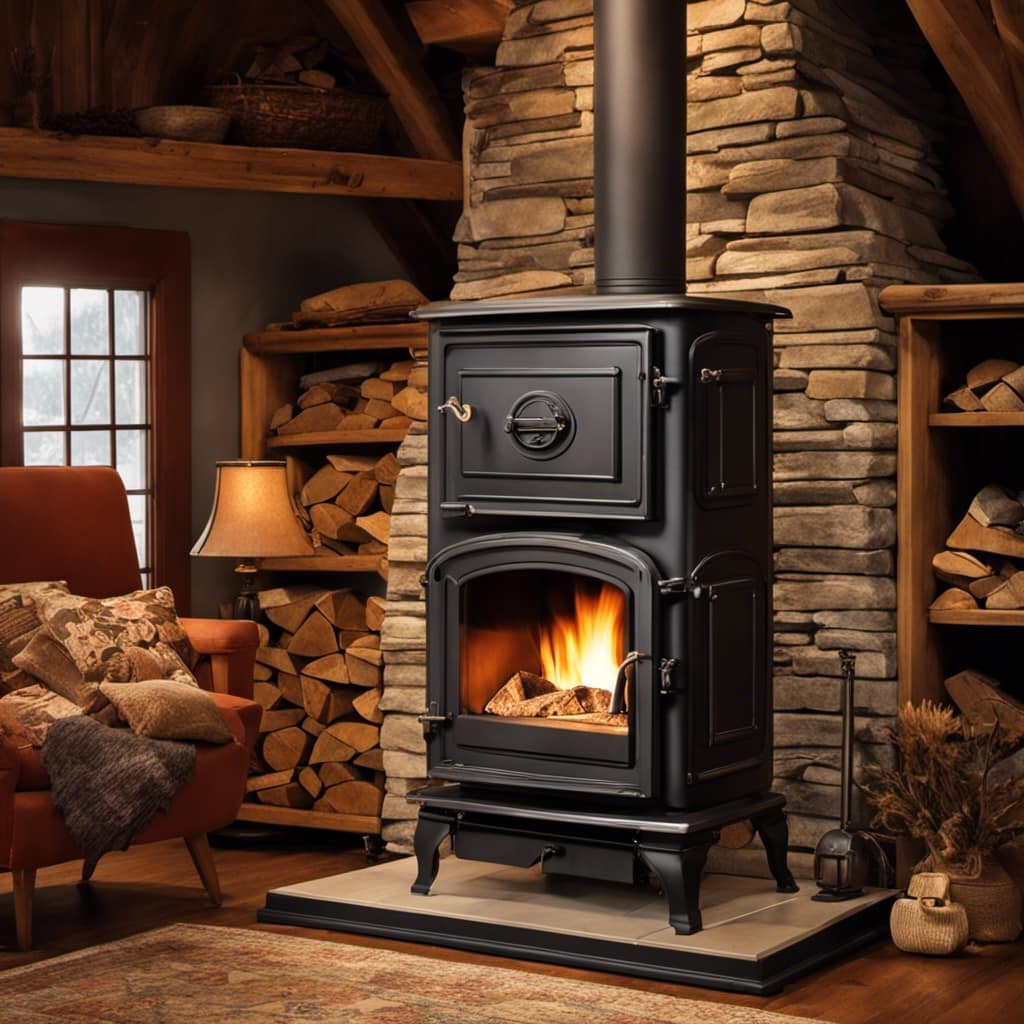
Growing up surrounded by the vast beauty of nature, Sierra was always drawn to the call of the wild. While others sought the comfort of the familiar, she ventured out, embracing the unpredictable and finding stories in the heartbeat of nature.
At the epicenter of every remarkable venture lies a dynamic team—a fusion of diverse talents, visions, and passions. The essence of Best Small Wood Stoves is crafted and refined by such a trio: Sierra, Logan, and Terra. Their collective expertise has transformed the platform into a leading authority on small wood stoves, radiating warmth and knowledge in equal measure.
Wood Stove
What Does A Refractory Board On Wood Stove Do
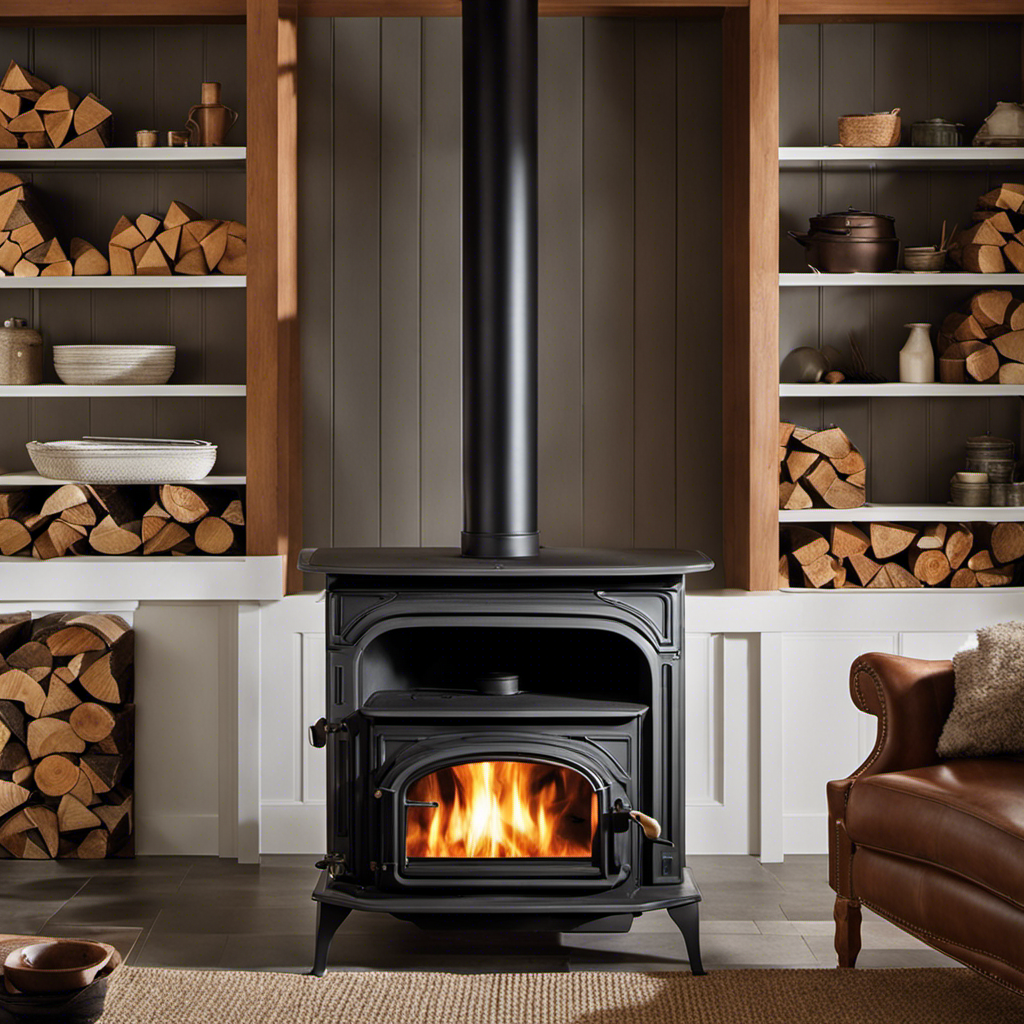
Were you aware that incorporating a refractory board into your wood stove can markedly enhance its efficiency? Indeed, it is true!
With its heat-resistant properties, a refractory board acts as a barrier, protecting your wood stove from extreme temperatures and preventing damage.
Not only does it enhance the heat efficiency of your stove, but it also ensures a longer lifespan.
In this article, I’ll delve into the benefits of a refractory board and provide helpful tips for choosing and maintaining the right one for your wood stove.
Key Takeaways
- Provides insulation and retains heat generated by the wood stove
- Acts as a thermal barrier, preventing heat escape and reducing energy wastage
- Regulates and maintains consistent temperature inside the stove
- Protects interior components, extending the lifespan of the wood stove
The Purpose of a Refractory Board
I learned that the main purpose of a refractory board is to provide at least two layers of insulation for the wood stove. The benefits of using a refractory board are numerous.
Firstly, it helps to retain the heat generated by the wood stove, ensuring that it’s efficiently utilized to warm the surrounding area. Additionally, the insulation provided by the refractory board helps to prevent the escape of heat, reducing energy wastage and ultimately saving on heating costs.
There are various types of refractory materials that can be used for wood stoves, including ceramic fiber boards, calcium silicate boards, and vermiculite boards. Each type has its own unique properties, such as high-temperature resistance and excellent heat retention, making them suitable for different applications.
Ultimately, the use of a refractory board in a wood stove greatly enhances its performance and efficiency.
How a Refractory Board Protects Your Wood Stove
During colder months, a refractory board acts as a barrier and protects your wood stove from excessive heat, ensuring its longevity. The insulating properties of the board help to prevent heat damage to the stove and surrounding areas. This is achieved by absorbing and distributing the intense heat generated by the burning wood, thereby reducing the risk of overheating and potential fire hazards. The refractory board also acts as a thermal barrier, preventing heat from escaping through the walls of the stove and increasing its overall efficiency. Additionally, the board helps to regulate the temperature inside the stove, allowing for more controlled and efficient burning of wood. Overall, the presence of a refractory board is crucial for maintaining the safety and performance of your wood stove.
| Benefits of a Refractory Board | How it Works |
|---|---|
| Insulating properties | Absorbs and distributes heat |
| Preventing heat damage | Acts as a thermal barrier |
| Increasing stove efficiency | Regulates temperature |
| Ensuring safety | Reduces risk of fire hazards |
Enhancing Heat Efficiency With a Refractory Board
Using a refractory board in your wood stove can significantly enhance heat efficiency and reduce energy waste. Here’s how it works:
-
Insulation: A refractory board acts as insulation, preventing heat from escaping through the walls of the stove and maximizing heat output inside the stove.
-
Heat Reflection: The board reflects heat back into the firebox, increasing energy savings by ensuring that more heat is utilized for heating the room instead of being lost.
-
Heat Distribution: It helps distribute heat evenly throughout the stove, ensuring that all areas of the stove are heated efficiently.
-
Temperature Regulation: The board helps in regulating and maintaining a consistent temperature inside the stove, optimizing energy usage and reducing fuel consumption.
-
Protection: It protects the interior components of the wood stove from extreme temperatures, extending the lifespan of the stove and reducing maintenance costs.
Choosing the Right Refractory Board for Your Wood Stove
When selecting a refractory board for my wood stove, it’s essential to consider factors such as durability, heat resistance, and ease of installation.
A refractory board plays a crucial role in enhancing the insulation benefits of a wood stove. It acts as a barrier, preventing heat from escaping and ensuring maximum heat efficiency. The insulation properties of the board help maintain a consistent and controlled temperature inside the stove, resulting in more efficient burning and reduced energy consumption.
In addition to insulation benefits, durability is a key factor to consider when choosing a refractory board. It should be able to withstand high temperatures without cracking or deteriorating over time.
Ease of installation is also important for a hassle-free setup. Taking these factors into account will ensure that you select a high-quality refractory board that meets your needs.
Now, let’s explore some maintenance tips for a long-lasting refractory board.
Maintenance Tips for a Long-lasting Refractory Board
I’ve found that by regularly inspecting and cleaning around the refractory board, as well as applying a protective sealant, I can ensure its long-lasting performance. The refractory board plays a crucial role in a wood stove, providing insulation and protecting the surrounding components from excess heat.
To maximize its longevity benefits, here are some cleaning techniques I recommend:
- Use a soft brush or vacuum to remove any dust or debris that may accumulate on the board.
- Wipe the board with a damp cloth to remove any stubborn dirt or stains.
- Avoid using abrasive cleaners or harsh chemicals that can damage the board’s surface.
- Apply a high-temperature sealant to protect the board from moisture and prevent cracks.
- Regularly check for any signs of wear or damage and address them promptly to prevent further issues.
Frequently Asked Questions
How Much Does a Refractory Board Cost?
Refractory boards have various applications, and their cost can vary depending on factors such as size and quality. They offer advantages such as heat resistance and durability, making them a valuable addition to wood stoves.
Can I Install a Refractory Board in My Existing Wood Stove?
Yes, you can install a refractory board in your existing wood stove. Refractory boards have many advantages, such as increasing heat efficiency and protecting the stove from damage. There are different types of refractory boards available to suit your specific needs.
How Long Does a Refractory Board Typically Last?
Typically, a refractory board on a wood stove lasts around 5-10 years. Signs of deterioration include cracks, crumbling, or a decrease in heat retention. When these signs appear, it’s time to replace the board.
Are There Any Specific Safety Precautions to Take When Using a Wood Stove With a Refractory Board?
When using a wood stove with a refractory board, it is important to take safety precautions. Regular maintenance is also necessary to ensure the board remains in good condition and maximizes its heat-resistant properties.
Can a Refractory Board Be Used in Other Heating Appliances, Such as Fireplaces or Outdoor Ovens?
A refractory board can also be used in heating appliances like fireplaces or outdoor ovens. It offers similar benefits as firebrick, but with added advantages such as heat retention and durability.
Conclusion
In conclusion, a refractory board is like the armor of a wood stove, protecting it from the intense heat and ensuring its longevity.
By creating a barrier between the fire and the stove, it prevents damage and enhances the stove’s efficiency by reflecting and radiating heat.
Choosing the right refractory board and regularly maintaining it will ensure a long-lasting and efficient wood stove experience.
So, think of a refractory board as the trusty shield that keeps your wood stove strong and roaring.
Logan’s affair with adventure began in childhood. He hailed from a small town where vast forests bordered one side and endless shores stretched on the other. His days were spent exploring uncharted woods, climbing tall trees, or listening to the tales of old sailors. This early immersion in a world brimming with stories and mysteries became the foundation of his passion for writing.
Wood Stove
Who Can Fix Wood Stove Glas Door In Pa
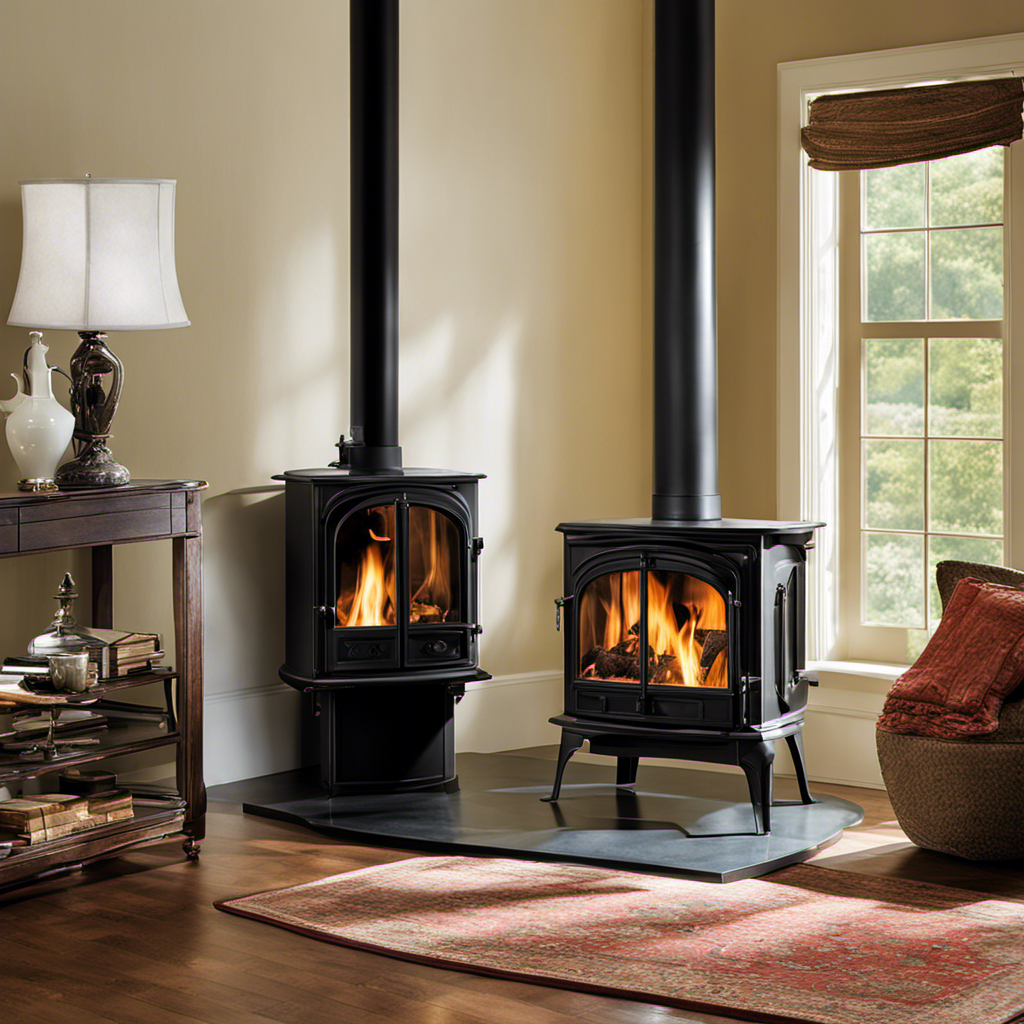
Living in Pennsylvania, I completely understand the annoyance of handling a damaged glass door on a wood stove. However, don’t worry, I’ve discovered a solution to fix this problem.
There are certified technicians in PA who specialize in fixing wood stove glass doors. If you’re feeling handy, there are also DIY options available. Additionally, some wood stove manufacturers offer repair services.
In this article, I will share tips on finding reliable wood stove glass door repair services in PA. Let’s get that door fixed and the warmth flowing again!
Key Takeaways
- Certified technicians in PA specialize in fixing wood stove glass doors.
- Local wood stove repair companies can handle common issues like cracks, chips, and fogging.
- DIY solution using vinegar and newspaper is effective for cleaning wood stove glass doors.
- Some wood stove manufacturers offer repair services for their products.
Local Wood Stove Repair Services
I need to find a local wood stove repair service near me to fix my wood stove before the winter season starts. It’s important to address any issues with the wood stove, especially with the glass doors. Common issues with wood stove glass doors include cracks, chips, or even fogging due to the intense heat.
Local wood stove repair companies are equipped to handle these problems and ensure that the doors function properly. They’ve the expertise to repair or replace the glass doors efficiently. By contacting a local wood stove repair service, I can trust that my wood stove will be in good hands and ready for the colder months ahead.
Now, let’s discuss the importance of certified wood stove glass door technicians.
Certified Wood Stove Glass Door Technicians
Since I live in an area with cold winters, it’s crucial to have certified wood stove glass door technicians who can ensure the safety and efficiency of my wood stove.
When it comes to wood stove door replacement, it’s important to hire professionals who are knowledgeable and experienced in this specific field. They understand the intricacies of wood stove doors and can ensure a proper fit and seal.
In addition, these technicians can provide valuable advice on wood stove glass cleaning techniques to maintain the clarity and effectiveness of the glass door. Regular cleaning is essential to remove soot and creosote buildup, which can affect the performance of the wood stove.
DIY Solutions for Wood Stove Glass Door Repair
The most effective way to repair a wood stove glass door is by using a DIY solution like vinegar and newspaper.
Wood stove glass door cleaning is a crucial maintenance task to ensure the optimal performance of your stove. Over time, the glass can become dirty and stained, hindering the view of the fire and diminishing the overall aesthetic appeal.
Common causes of wood stove glass door damage include the accumulation of soot, creosote, and ash, as well as high temperatures causing the glass to crack or shatter.
To clean the glass, mix equal parts vinegar and water, then apply the solution to the glass using newspaper. Gently scrub in circular motions to remove any stubborn stains.
Once done, wipe the glass clean with a damp cloth and admire the clear view of your cozy fire.
Wood Stove Manufacturers With Repair Services
I found a reliable wood stove manufacturer near me that offers repair services for their products. This is great news for anyone who owns a wood stove and wants to ensure it stays in top condition. As someone who’s dealt with common wood stove problems in the past, I know how frustrating it can be when your stove isn’t functioning properly. That’s why I wanted to share some wood stove maintenance tips to help you avoid these issues.
Here are two sub-lists with more in-depth information:
-
Cleaning and Maintenance:
-
Regularly clean the stove, removing any ash or debris.
-
Check and clean the chimney to prevent blockages and improve efficiency.
-
Troubleshooting Common Problems:
-
If the stove isn’t producing enough heat, check the air vents and make sure they’re open.
-
If you notice a smell of smoke in the room, check for leaks in the stove’s seals.
Tips for Finding Reliable Wood Stove Glass Door Repair Services in PA
I’ve heard that there are several reliable wood stove glass door repair services in PA that you can count on.
When it comes to local wood stove repair companies, it’s important to find one that’s experienced and trustworthy.
Common issues with wood stove glass doors include cracks, chips, and fogging. These problems can’t only affect the aesthetics of your wood stove, but they can also impact its functionality.
That’s why it’s crucial to find a repair service that can address these issues promptly and effectively.
Look for companies that specialize in wood stove glass door repair and have a proven track record of customer satisfaction.
Additionally, make sure they use high-quality materials and offer reasonable pricing.
With the right repair service, you can restore your wood stove glass door to its former glory and enjoy a cozy and efficient heating experience.
Frequently Asked Questions
How Much Does It Cost to Repair a Wood Stove Glass Door in Pennsylvania?
Repairing a wood stove glass door in Pennsylvania can cost anywhere from $100 to $500, depending on the extent of the damage and the professional you hire. DIY alternatives may be cheaper but require caution and skill.
Can I Repair a Cracked Wood Stove Glass Door Myself?
I can repair a cracked wood stove glass door myself. It requires careful handling and the right tools. First, remove the door. Then, clean the glass and apply a high-temperature adhesive. Finally, let it dry and reattach the door.
Are There Any Wood Stove Manufacturers in Pennsylvania That Offer Repair Services?
I’ve got great news for wood stove owners in Pennsylvania! There are wood stove manufacturers in the state that offer top-notch repair services, including wood stove glass replacement. You’re in good hands!
How Long Does It Typically Take to Repair a Wood Stove Glass Door?
On average, it takes about a few hours to repair a wood stove glass door. Common causes of damage include high heat, impact, or improper maintenance. It’s important to consult a professional for proper repair.
Are There Any Special Certifications or Qualifications Required to Become a Wood Stove Glass Door Technician in Pennsylvania?
As an expert wood stove glass door technician in Pennsylvania, I can assure you that there are indeed special certifications and qualifications required for this role. The intricate nature of the job demands precision and expertise.
Conclusion
Finding reliable wood stove glass door repair services in PA can be a daunting task, but fear not! Local repair services, certified technicians, and even DIY solutions are available to help fix your wood stove.
Additionally, some wood stove manufacturers offer repair services for their products. By considering these options and following these tips, you’ll be able to find the right professionals to restore your wood stove to its former glory.
So don’t wait, get your wood stove glass door fixed and enjoy the warmth and coziness it brings to your home.
Growing up surrounded by the vast beauty of nature, Sierra was always drawn to the call of the wild. While others sought the comfort of the familiar, she ventured out, embracing the unpredictable and finding stories in the heartbeat of nature.
At the epicenter of every remarkable venture lies a dynamic team—a fusion of diverse talents, visions, and passions. The essence of Best Small Wood Stoves is crafted and refined by such a trio: Sierra, Logan, and Terra. Their collective expertise has transformed the platform into a leading authority on small wood stoves, radiating warmth and knowledge in equal measure.
Wood Stove
How Much Does It Cost To Get Permits For A Wood Stove In Jefferson County Mo
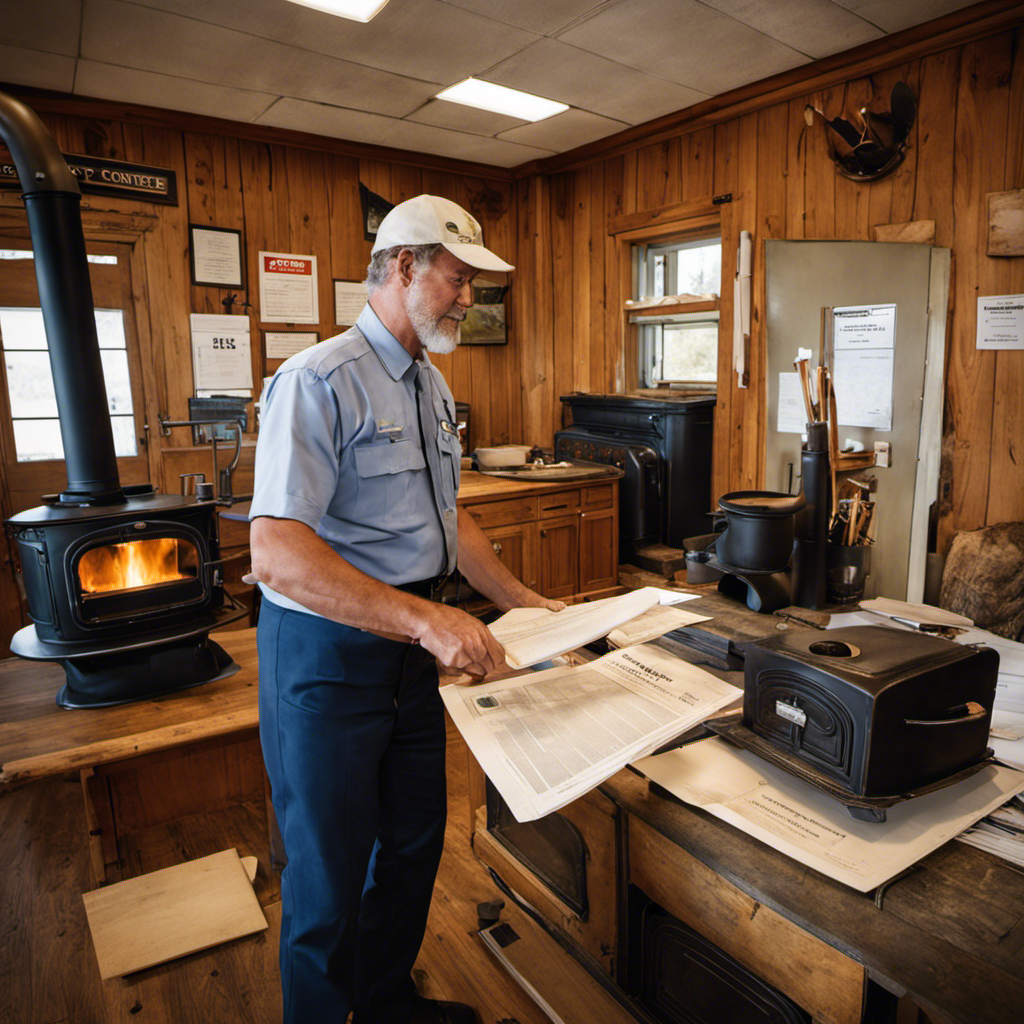
Considering installing a wood stove in Jefferson County, MO? Prior to enjoying the warm embrace of your fire, you must initially address the less enjoyable chore of securing the necessary permits.
But don’t worry, I’ve got you covered! In this article, I’ll break down the cost of getting permits for a wood stove in Jefferson County. From application process to fees and even tips for saving money, we’ll cover it all.
Let’s get started!
Key Takeaways
- The permit application process for a wood stove in Jefferson County, MO involves a timeline, avoiding common mistakes, submitting documents on time, and inspection of the installation.
- The cost breakdown for permit fees includes varying costs depending on the type of permit, such as a $50 installation permit fee, $40 inspection fee, and $25 processing fee for each application. However, veterans and low-income residents may qualify for permit fee waivers.
- Additional expenses to consider include installation requirements and associated fees, maintenance and inspection fees, the impact of these expenses on the overall cost, and budgeting for chimney cleaning and maintenance.
- Tips for saving money on permit costs include timing the application during off-peak seasons, preparing all necessary documentation, ensuring proper sizing of the wood stove, researching and planning ahead, and minimizing costs to stay within budget.
Overview of Permit Requirements
I understand the overview of permit requirements and will ensure that all necessary documents are submitted.
When it comes to obtaining permits for a wood stove in Jefferson County, it’s important to be aware of the permit application timeline and avoid common permit mistakes.
The permit application timeline typically involves submitting the application and supporting documents, followed by an inspection of the installation. It’s crucial to submit the application in a timely manner to avoid any delays in the approval process.
Additionally, it’s essential to double-check all the required documents to avoid common permit mistakes such as missing information or incorrect forms.
Permit Application Process
The permit application process requires careful attention to detail and thorough documentation, but it can be completed efficiently with proper guidance. To ensure a smooth and timely process, it’s important to understand the permit processing time and the required documentation.
Here are the key points to keep in mind:
-
Permit processing time: It’s essential to be aware of the average processing time for permits in your area. This will help you plan your project accordingly and avoid any delays.
-
Required documentation: The application will typically require specific documents such as building plans, permits from other departments, contractor information, and proof of insurance. It’s crucial to gather all the necessary paperwork to avoid any setbacks in the review process.
-
Guidance and assistance: Seeking guidance from professionals or experienced individuals who’ve gone through the process can be immensely helpful. They can provide valuable insights and ensure that your application is complete and meets all the requirements.
Cost Breakdown for Permit Fees
A breakdown of the cost for permit fees can be found in the county’s official documentation.
As I researched the permit application process for getting permits for a wood stove in Jefferson County, I discovered that the cost varies depending on the type of permit needed.
For example, the installation permit fee is $50, while the inspection fee is $40. Additionally, there’s a processing fee of $25 for each permit application.
The county also offers permit fee waivers for certain individuals, such as veterans and low-income residents.
It’s important to note that the permit application timeline can range from a few days to a few weeks, so it’s advisable to plan ahead and submit the application well in advance of the desired installation date.
Additional Expenses to Consider
When budgeting for a wood stove installation, it’s crucial to factor in the cost of additional expenses, such as chimney cleaning and maintenance. These additional expenses are important to consider because they can significantly impact the overall cost of installing and maintaining a wood stove.
Some of the key additional expenses to keep in mind include:
-
Installation requirements: Depending on your location, there may be specific installation requirements that need to be met, such as permits or inspections. These requirements often come with associated fees.
-
Maintenance and inspection fees: Once your wood stove is installed, regular maintenance and inspections are necessary to ensure its safety and efficiency. These services typically come with fees that need to be factored into your budget.
Considering these additional expenses alongside the cost of the wood stove itself will give you a more accurate picture of the total investment required.
Now, let’s move on to some tips for saving money on permit costs.
Tips for Saving Money on Permit Costs
As someone who frequently installs wood stoves, I’ve found that it’s essential to research and plan ahead in order to save money on permit costs. In Jefferson County, MO, obtaining permits for wood stove installations can be a significant expense. However, by implementing a few simple tips and strategies, you can minimize these costs and stay within your budget.
| Strategy | Description |
|---|---|
| 1. Timing | Schedule your permit application during off-peak seasons when demand is lower and fees may be reduced. |
| 2. Adequate Documentation | Prepare all necessary documents, including the manufacturer’s specifications, installation manual, and any additional certifications required by the local authorities. |
| 3. Proper Sizing | Ensure that your wood stove is appropriately sized for your space to avoid costly modifications or rejections during the inspection process. |
Frequently Asked Questions
Are There Any Restrictions on the Size or Type of Wood Stove That Can Be Installed With a Permit in Jefferson County, Mo?
There are restrictions on the size and type of wood stove that can be installed with a permit in Jefferson County, MO. The cost of the permit for wood stove installation depends on various factors.
How Long Does It Typically Take to Receive a Permit for a Wood Stove Installation in Jefferson County, Mo?
Typical wait times for a wood stove permit in Jefferson County, MO, can vary, but it usually takes around 2-4 weeks. Common delays may occur due to incomplete applications or high demand.
Are There Any Specific Guidelines for the Installation of a Wood Stove, Such as Clearance Requirements or Ventilation Standards?
There are specific guidelines for wood stove installation in Jefferson County, MO. These include clearance requirements and ventilation standards. It’s important to follow these guidelines for safe and proper installation.
Do I Need to Hire a Professional Contractor to Install a Wood Stove, or Can I Do It Myself With a Permit in Jefferson County, Mo?
I can install a wood stove myself with a permit in Jefferson County, MO. However, it’s recommended to hire a professional contractor for safety reasons. The cost of professional installation varies depending on the complexity of the job.
Are There Any Ongoing Maintenance or Inspection Requirements for Wood Stoves in Jefferson County, MO, After Obtaining a Permit?
After obtaining a permit for a wood stove in Jefferson County, MO, there are ongoing maintenance requirements and inspection requirements. It is important to regularly maintain and have the stove inspected to ensure safety and compliance.
Conclusion
In conclusion, obtaining permits for a wood stove in Jefferson County, MO can be a costly process. However, with proper planning and research, homeowners can save money on permit costs.
Remember, ‘a penny saved is a penny earned.’ So, make sure to thoroughly understand the permit requirements, navigate the application process efficiently, and consider all additional expenses before installing a wood stove.
Growing up surrounded by the vast beauty of nature, Sierra was always drawn to the call of the wild. While others sought the comfort of the familiar, she ventured out, embracing the unpredictable and finding stories in the heartbeat of nature.
At the epicenter of every remarkable venture lies a dynamic team—a fusion of diverse talents, visions, and passions. The essence of Best Small Wood Stoves is crafted and refined by such a trio: Sierra, Logan, and Terra. Their collective expertise has transformed the platform into a leading authority on small wood stoves, radiating warmth and knowledge in equal measure.
-

 Wood Stove4 weeks ago
Wood Stove4 weeks agoWhen To Open And Close Damper On Wood Stove
-

 Wood Stove3 weeks ago
Wood Stove3 weeks agoHow To Build A Thermoelectric Generator For A Wood Stove
-

 Wood Stove4 weeks ago
Wood Stove4 weeks agoHow To Use Damper And Draft On Wood Stove
-

 Wood Stove3 weeks ago
Wood Stove3 weeks agoHow Does A Circulator Wood Stove Work
-

 Pellet Stoves2 days ago
Pellet Stoves2 days agoWhy Is My Wood Pellet Stove Putting so Much Soot
-

 Wood Stove3 weeks ago
Wood Stove3 weeks agoHow Far Does Wood Stove Have To Be From Wall
-

 Wood Stove4 weeks ago
Wood Stove4 weeks agoWhat Can I Use As Insulation On Wood Stove Pipes
-

 Pellet Stoves4 days ago
Pellet Stoves4 days agoHow to Make a Pellet Basket for Wood Burning Stoves








